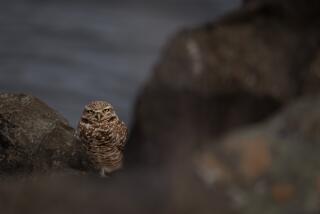Small, yet groundbreaking
- Share via
FRANKLY, it bothered me. Last spring, breaking ground on a school garden set in what had been a parking lot in the heart of old Los Angeles, kids found more earthworms in one day than I have found in my garden in the last six years. Most of the adults -- a mix of teachers and horticulturally inclined do-gooders -- chortled fondly about how wonderful it was to see youth grasping nature. I was less amused. How, I wondered, could these kids be hitting this kind of squirming pay dirt with their first stab in the soil? How, how, how could a borderline Superfund site have more earthworms than my organic Mediterranean garden?
I am not proud that it took envy of third-graders to prompt my first look at the earthworm, but I’m glad that something provoked it all the same. The earthworm, it turns out, is not just essential to tilth. It’s an infinitely interesting beastie. Look into the hands of those children, and you find the invertebrate that prompted Charles Darwin to say, “It may be doubted whether there are many other animals which have played so important a part in the history of the world, as have these lowly organized creatures.”
Standing in that schoolyard, I realized that I had staked my pride as a gardener on the presence of creatures that I knew next to nothing about. So I set out to learn a thing or two about the animals that make earth.
The first surprise was to find that “the earthworm” was in fact more than 4,000 species of creatures worldwide. The terms are not hard and fast. No two texts give the same names. In common with many plant names, the taxonomy, or the way biologists classify this slithering mass, moves as fast as a worm diving down its burrow. Even experts rarely settle on one family, never mind genus, to describe the earthworm. Out of five families commonly discussed in American texts, only several dozen species recur as dominant in California. One day soon I may banter easily using the family names of the Lumbricidae, Acanthodrilinae, Ocnerodrilinae and Sparganophilidae, but for now, I’m sticking with “earthworm.”
Where the $10 words did come in handy was in producing three terms for distinct types of worms that occupy three separate layers of earth: epigeic, endogeic and anecic, or surface, shallow and deep. The epigeic worms are the ones given to scooting around in mulch and chewing up fallen leaves and manure, turning them into hummus. They are so exposed, you don’t see a whole lot of old ones. They are usually picked off by birds as juvies. They include red worms, the kind that come sealed in plastic cups with compost bins.
The second type, endogeic earthworms, work just beneath the soil surface. According to a collection of excellent papers by Matthew Werner, a retired wormologist from UC Santa Cruz, they take out dead roots and mix and aerate soil. Finally there are the anecic earthworms, which burrow vertically, living in deep holes by day, but surfacing by night to do their work as “detrivores,” browsing on fallen leaves and suitably tender, rotting organic matter. These, say most wormologists, do the heavy lifting in soil ecology, processing fallen leaves and turning over as much as 2 inches of soil every year.
The most common worm, the one most people mean when they say “earthworm,” turned out to be one of the deep diggers. Also called a night crawler, or Lumbricus terrestris, it is such a tunneler that during rainy season, its burrows serve as important channels for plant roots to penetrate and carry rain water deep into the soil. On days after rains, many end up stranded outside their burrows -- perhaps because they are waterlogged. The world seems to divide up between people who stop and bend over to return night crawlers stranded on sidewalks back to grass, and those who step over them. When exhumed by a gardener’s shovel, it’s easy to mistake a night crawler for its endogeic, or shallower, cousin, the “Southern worm,” or Aporrectodea trapezoides.
What most California gardeners would be unlikely to encounter are native earthworms. Wormologists speculate that northern states lost their native earthworms during the Pleistocene, when glaciers crept down through Canada and froze everything in their path. California escaped the glaciations and kept its native worms, except, that is, where Europeans moved in. Here, native worms have been systematically displaced by farming and construction. In their stead have followed night crawlers. The European earthworm’s cocoons first came to California stuck in hoofs of settlers’ livestock, or riding in food supplies, or dropped by birds.
As these became established, what settlers started, sportsmen escalated. Much of the spread of the night crawler and related species is put down to fishermen tossing unused bait into streams. Last but not least: The worms arrived from Europe nestled in the base of nursery pots.
California has earthworms from every country it has plants. In 1993 a U.S. Department of Agriculture survey found worms from Europe, South America and Africa outnumbering our native worms in the wild areas surrounding Los Angeles: the Arroyo Seco and Mt. Baldy in the Angeles National Forest, Los Padres National Forest, Point Mugu, San Dimas, the Lake Arrowhead area in the San Bernardino National Forest, Santa Rosa Plateau, and the Cleveland National Forest.
Although our European earthworms are usually a good thing, in wild environments, night crawlers can be too much of a good thing. Conservationists in Minnesota and across the upper Midwest worry about earthworms eating too much under-story vegetation in northern forests, where the ecology developed without worms since the last ice age. It’s simply not understood how foreign worms are affecting the wilds of Southern California.
Where most of us would like to see more of them is in cultivated environments, where with time and yearly mulching, they turn clay into loam. They are voracious recyclers because they need to ingest massive amounts of rotting organic matter to get their nourishment. This comes from tiny components of all that roughage -- the protozoa, bacteria and fungi carried on it. So they extrude not only hummus, says Clive Edwards, a professor of entomology at Ohio State University, but also lots of useful microorganisms important in nitrogen fixation and nutrient uptake by plants.
For organic fruit farmers, earthworms are thought to improve the earth as well as be an essential safeguard. By consuming all in their path, they act as filters, devouring infected foliage in apple orchards affected by fire blight and scab fungus, preventing successive infections.
Edwards is a co-author of one of the first pieces of required reading for soil scientists: “Biology and Ecology of Earthworms.” Check this out of the Los Angeles Public Library and you’ll learn enough gross-out stuff to keep a pack of kids entertained for years. The earthworm’s body has a mouth at one end, anus at the other, four or five hearts, two sexes and abdomens that practically invented wriggling.
Earthworms must stay moist but can survive great desiccation. During extreme heat, drought or cold, they tunnel. Some hibernate. Chop them in half and with the right conditions, the front half can regenerate. “You don’t get two earthworms,” says Edwards. Occasionally, some poor worm ends up with two tails.
They need slime to survive. These watery creatures rely on excretions that ease friction and, as the goo dries, become a building material that reinforces their tunnels. Although hermaphroditic, most must breed, and -- the bit left out of most school packets -- they shame many humans by having sex for an hour. After eggs are fertilized, the worm handily slips off a band to encase a lemon-shaped cocoon.
As Darwin noted first, they have no eyes but sense light. They show distinct foraging patterns, preferring to drag leaves into the burrows with the tips, not stems. Cutting up paper triangles and then experimenting with foreign plants, Darwin tested their relationship to shape again and again, and commented, “We can hardly escape from the conclusion that worms show some degree of intelligence in their manner of plugging up their burrows.”
There is plugging, and there is disappearing. The indignity for the Mediterranean gardener, I told Edwards, has been finding more worms in lawns than in mulched beds with more (righteous sniff) appropriate plants. Edwards refused to indulge me.
“It’s the lawn!” he exclaimed. “When you get grass, with a mass of organic matter at the base, that’s exactly what they love.”
The trick to promoting earthworms without lawn is to mulch lavishly, he says, and to avoid ammonia-based fertilizers. Surprisingly, worms can survive applications of many pesticides. The problem here, according to UC Davis researchers, is that pesticides, heavy metals and other contaminants can accumulate at levels 10 times higher than in the surrounding soil. This makes them a potentially lethal meal for birds and their predators. Fishermen, particularly, should think twice about what they dangle from their hooks before they chem-garden.
They say all the world passes through earthworms. Recently it has felt like all the world except my garden. I mulch and keep an organic garden. So where were the worms? Then I remembered something else from Edwards’ book: Earthworms like it moist. When soil dries out, the tunneling worms burrow ever more deeply, following the water.
I decided on another test. Walking around the garden, I randomly drove a shovel in to check soil texture. Time after time, it slid in with surprising ease. I no longer needed to see a night crawler writhe at the end of the shovel, or wriggling to escape the palm of an excited kid. This sweet-smelling, soft earth could only have been the work of earthworms.
Emily Green can be reached at emily.green@latimes.com.






